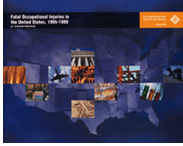Fatal Occupational Injuries in the United States, 1995-1999:
A Chartbook
| Contents of Report | |
| Cover (PDF 316K) | |
| Table of Contents (PDF 42K) | |
| Title Page (PDF 70K) | |
| Commissioner's Letter (PDF 178K) |
|
| Acknowledgments (PDF 70K) | |
| Introduction (PDF 321K) | |
| National Profiles | |
| Industry Profiles | |
| State Profiles | |
| Appendix I (PDF 59K) | |
| Appendix II (PDF 88K) | |
| Appendix III (PDF 92K) | |
| Entire Report (PDF 2,801K) |
 Fatal Occupational Injuries in the United States, 1995-1999: A Chartbook (BLS Report 965) is presented on this website in Adobe PDF format. See the Contents of Report box at left to access the various sections of the report. The entire report (PDF 2,801K) is also available in a single PDF file.
Fatal Occupational Injuries in the United States, 1995-1999: A Chartbook (BLS Report 965) is presented on this website in Adobe PDF format. See the Contents of Report box at left to access the various sections of the report. The entire report (PDF 2,801K) is also available in a single PDF file.
The excerpt from the introduction below describes the structure of the chartbook. You can also find important information below about accessibility, as well as tips for printing chartbook PDF files.
A contacts page is provided in HTML format for your convenience. The page lists State and National contacts for Census of Fatal Occupational Injuries data.
Order a free copy. Single copies of the print version of Fatal Occupational Injuries in the United States, 1995-1999: A Chartbook are available. To obtain a copy, send email to blsdata_staff@bls.gov with your mailing address included in your request; mail a request to the Office of Publications and Special Studies, U.S. Department of Labor, Bureau of Labor Statistics, Washington, D.C., 20212; or call 202-691-5200.
Introduction (Excerpt)
The Census of Fatal Occupational Injuries, the Nation’s primary source of data on fatal work injuries, has begun its second decade of operation. The program, which is conducted by the Bureau of Labor Statistics (BLS) in partnership with State agencies, provides valuable information to make workplaces safer for all workers. This chartbook presents an overview of fatal work injury data from the Census of Fatal Occupational Injuries program for the 5 years from 1995 through 1999. The chartbook presents these data in an easily accessible format—more charts and graphs than text or analysis—that will be useful to anyone interested in learning more about fatal occupational injuries, whether that person is an experienced researcher or an interested observer. It illuminates the details of these fatal injuries from a variety of perspectives.
Organization of the Chartbook
The chartbook is divided into three sections; each begins with a short overview of the data which is followed by more specific data presentations. The National Profiles focus on specific types of fatal work injuries, sources of fatal injuries, and specific groups of workers. These topics were selected because they have proven to be of ongoing interest to data users. The Industry Profiles present data for each major industry division, including the number and rate of fatal work injuries in that division as well as background on the demographic characteristics of the fatally injured workers and the fatal incidents.
The State Profiles section focuses on fatal work injury data for individual States, plus the District of Columbia and New York City. Each profile in this section includes data on the number and rate of fatal incidents, as well as charts and tables showing the types of events, occupations, and industries associated with fatal work injuries in a particular State or location. Summaries of the demographic characteristics of the fatally injured workers also are presented in each State profile.
The appendixes provide contact information for Census of Fatal Occupational Injuries staff in the BLS office in Washington, DC, as well as for the BLS Regional Information Offices and the State agencies. The appendixes also contain technical information regarding the methodology of the fatality census program.
![]() Read Entire Introduction (PDF 321K)
Read Entire Introduction (PDF 321K)
Accessibility
Data from the Census of Fatal Occupational Injuries are used for injury surveillance, safety research, safety promotion, safety training, regulations assessments, and many other safety-related issues. The key to a successful statistical program is to provide the data to people who can make a difference. Accomplishing that requires easily accessible information, which the fatality census strives to produce. Aggregated data and reports from the fatality census can be obtained via the Internet, e-mail, facsimile, telephone, annual publications, and research/journal articles. (See appendix III (PDF 92K) for contact information.)
Printing Tips
PDF files on the Bureau of Labor Statistics website are best viewed with Adobe Acrobat Reader 5.0 or higher. The chartbook PDF files print best if the following settings are used in Acrobat 5.0: On the Print screen, under Copies and Adjustments, check the box next to "Auto-rotate and center pages" and leave the two boxes just above that one unchecked. (For other versions of Adobe Acrobat, the print options may be presented somewhat differently.)
Last Modified Date: February 7, 2005

